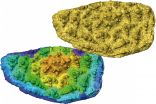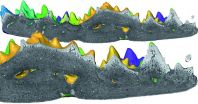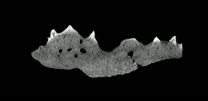Forgotten fossil indicates earlier origin of teeth
2015-06-24
(Press-News.org) The tooth plate of just some millimeters in size had been in a box for more than 40 years, without being recognized after the discovery and preparation of the fish it belonged to. Palaeontologists from Naturalis Biodiversity Center, Netherlands and the University of Bristol, United Kingdom, studied the fossil using high energy X-rays at the Swiss Light Source at the Paul Scherrer Institut in Switzerland, revealing the structure and development of teeth and bones. Their findings are published today in Biology Letters.
Teeth are important in our daily life, they are crucial to munch and crunch our food. Jaws and teeth have been important innovations in the evolution of vertebrate animals. More than 98% of vertebrate animals have jaws.
Nevertheless earliest conditions and their origin are disguised in deep time. The search for fossil teeth of the earliest jawed vertebrates can literally be like the search for the needle in a haystack. This includes looking through boxes full of crumb sized bits and pieces of fossils remaining after dissolving rocks in acid.
Lead author, Martin Rücklin of Naturalis Biodiversity Center in Leiden says: "We were able to visualize the finest internal structures and distinguish tissues inside one of the first tooth plates. With powerful computing we combined thousands of X-rays and produced computer models reconstructing the growth of the first teeth."
Philip Donoghue from the University of Bristol in the UK explains: "We show that the earliest teeth were like our own - but also structured like body scales in primitive fishes. This supports the view that teeth evolved from scales, which arose much earlier in vertebrate evolution."
Rücklin adds: "Our results suggest that teeth originated deeper in the tree of life than we thought. We will have to look into more basal jawed vertebrates and also jawless fossils. Earliest jaws and teeth seem to be less integrated than we thought and teeth look more complex than expected. I am very happy that my research and our collaboration will be supported by the Vidi-grant of the Netherlands Organization for Scientific Research (NWO) in the next five years, enabling us to investigate these early stages of teeth and how the complex system of our own jaws and teeth evolved."
INFORMATION:
This work was funded by the EU Framework Programme 7, the Natural Environment Research Council and the Paul Scherrer Institut.
ELSE PRESS RELEASES FROM THIS DATE:
2015-06-24
A digital map of the ageing brain could aid the diagnosis of Alzheimer's disease and other neurodegenerative disorders in older people, a study suggests.
The atlas created using images from MRI scans of older people could aid diagnosis by comparing the patients' scans with a detailed map of the healthy ageing brain.
Most existing MRI atlases are based on the brains of young and middle-aged people, which don't reflect the normal changes that take place in the brain as we age, the team says.
Researchers at the University of Edinburgh constructed a detailed atlas of ...
2015-06-24
Various diagnostic imaging techniques are currently used for clinical imaging/disease diagnosis. The accuracy of diagnosis is mainly based on the type of energy used (such as X-ray, sound waves, photons and positrons) to derive the visual information, as well as the degree of spatial resolution (mesoscopic or microscopic) and the level of information that can be obtained (physiological, anatomical or molecular). Based on potential health hazards imposed by type of energy used, clinical imaging modalities can be broadly categorized as ionizing and non-ionizing modalities. ...
2015-06-24
Milan, Italy - 24 June 2015: Uninterrupted treatment with novel oral anticoagulants (NOACs) during catheter ablation of atrial fibrillation (AF) is safe, reveals research presented today at EHRA EUROPACE - CARDIOSTIM 2015 by Dr Carsten Wunderlich, senior consultant in the Department of Invasive Electrophysiology, Heart Centre Dresden, Germany.1 Continuation of NOAC therapy was not associated with periprocedural bleeding or thromboembolic complications.
The joint meeting of the European Heart Rhythm Association (EHRA) of the European Society of Cardiology (ESC) and Cardiostim ...
2015-06-24
TORONTO, ON - Adults who were exposed to childhood adversity, including witnessing parental domestic violence, childhood physical and sexual abuse have higher odds of experiencing migraine headaches in adulthood, according to a new study from researchers at the University of Toronto.
"We found the more types of violence the individual had been exposed to during their childhood, the greater the odds of migraine. For those who reported all three types of adversities--parental domestic violence, childhood physical and sexual abuse--the odds of migraine were a little over ...
2015-06-24
Scientists have demonstrated for the first time the ability to rapidly, reliably and simultaneously identify the 'handedness' of different molecules in a mixture.
The research, led by chemists at The University of Nottingham and the VU University Amsterdam, and published in the academic journal Nature Communications, could offer a new technique to easily distinguish whether a molecule is present in a left- or right-handed form.
The breakthrough could be important in developing effective molecules for use in a wide range of industries -- everything from the development ...
2015-06-24
Piscataway, N.J. -- A form of 'virtual-reality' therapy may help people with alcohol dependence reduce their craving for alcohol, a new study suggests.
The findings, published in the July issue of the Journal of Studies on Alcohol and Drugs, come from a small study of just 10 patients. But researchers said they are optimistic about the potential for virtual reality as a therapy for alcohol use disorders.
'This technology is already popular in the fields of psychology and psychiatry,' said senior researcher Doug Hyun Han, M.D., Ph.D., of Chung-Ang University Hospital ...
2015-06-24
Changes in the gut bacteria of colon cancer patients indicate that some virulent bacteria could be linked to the progression of the disease, according to research published in the open access journal Genome Medicine. The findings could eventually be used to identify a virulence signature in these cancers and help doctors predict how bacterial changes in patients' guts could affect their prognosis.
The human gut microbiome, the collection of microorganisms, their genomes and habitat that contributes to maintaining a healthy intestine, is thought to play an active role ...
2015-06-24
Despite a general consensus among scientists and in the racing industry that racehorse speed has plateaued, a new study from the University of Exeter has found that racehorses are getting quicker. Further research is required to determine whether the increased speeds have a genetic basis or are the result of improved training, jockey tactics or other environmental factors.
It had appeared that racehorse speeds were not improving and previous studies concluded that thoroughbred racehorses may have reached the limits of their abilities. However these studies only analysed ...
2015-06-24
A single gene called Angiopoietin-1 (Ang-1) drives brain size and intelligence in fish according to a new study by researchers at UCL, Stockholm University and University of Helsinki.
Fish with larger brains and higher intelligence had higher expression of Ang-1, and when expression levels of Ang-1 were experimentally reduced, brains shrunk. These trends were seen in two unrelated species of fish - guppies (Poecilia reticulata) and zebra fish (Danio rerio) - indicating expression of Ang-1 is important for brain growth and development in fish generally.
The study, published ...
2015-06-24
Living in an area with noisy road traffic may reduce life expectancy, according to new research published in the European Heart Journal.
The findings suggest a link between long-term exposure to road traffic noise and deaths, as well as a greater risk of stroke, particularly in the elderly. The research was led by the London School of Hygiene & Tropical Medicine in partnership with Imperial College London and King's College London.
Researchers analysed data for 8.6 million people living in London between 2003 and 2010. They looked at levels of road traffic noise during ...
LAST 30 PRESS RELEASES:
[Press-News.org] Forgotten fossil indicates earlier origin of teeth



